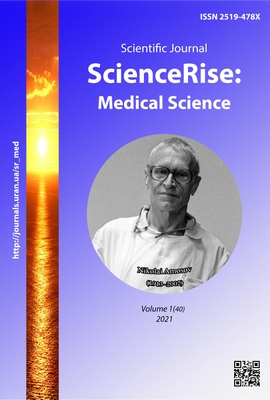Gastroesophageal reflux disease and autoimmune thyroiditis: features of pathomorphological manifestation in young people
DOI:
https://doi.org/10.15587/2519-4798.2021.224335Keywords:
gastroesophageal reflux disease, autoimmune thyroiditis, students, pathomorphological featuresAbstract
The aim of the work. To study the effect of concomitant autoimmune thyroiditis (AIT) on the pathomorphological features of lesions of the esophageal mucosa in young patients with gastroesophageal reflux disease (GERD).
Material and research methods. The study included 165 individuals. The contingent of the surveyed was students of Kharkov higher educational institutions. The main group consisted of 120 patients with a combined course of GERD and AIT, the comparison group included 65 individuals with an isolated GERD. The morphological form of the GERD was revealed during esophagogastroduodenoscopy (“Fuginon” system). A histomorphological study of the obtained biopsy material from the mucous membrane of the esophagus was carried out. Samples were studied on an Olympus BX-41 microscope. Morphometric study of the esophageal mucosa was performed using the Olympus DP-Soft.
Research results. Histological examination of biopsy specimens revealed that the main pathomorphological signs of GERD in both groups were hyperplasia of the basal zone, lengthening of epithelial papillae, leukocyte infiltration, intercellular edema, expansion of the intercellular space, dystrophic changes, submucous fibrosis, the presence of severe inflammatory infiltration in the submucosal layer. Presence of concomitant AIT was associated with a statistically higher frequency of occurrence of certain signs: hyperplasia of the basal layer of the epithelium, elongation of the papillae, epithelial edema, expansion of the intercellular space, dystrophic changes in the epithelium (p<0.05).
Conclusions. The presence of concomitant AIT in young patients with GERD does not affect the incidence of erosive GERD, but is associated with a significant increase in the severity of erosive esophagitis. The comorbid course of GERD and AIT in the student population is accompanied by a significant increase in the incidence and statistically significant intensification of the severity of hyperplasia of the basal layer of the epithelium, elongation of connective tissue papillae and leukocyte infiltration compared with isolated GERD
References
Clarrett, D. M., Hachem, C. (2018). Gastroesophageal Reflux Disease (GERD). Missouri medicine, 115 (3), 214–218.
Durazzo, M., Lupi, G., Cicerchia, F., Ferro, A., Barutta, F., Beccuti, G. et. al. (2020). Extra-Esophageal Presentation of Gastroesophageal Reflux Disease: 2020 Update. Journal of Clinical Medicine, 9 (8), 2559. doi: http://doi.org/10.3390/jcm9082559
Altomare, A., Guarino, M. P., Cocca, S., Emerenziani, S., Cicala, M. (2013). Gastroesophageal reflux disease: Update on inflammation and symptom perception. World Journal of Gastroenterology, 19 (39), 6523. doi: http://doi.org/10.3748/wjg.v19.i39.6523
El-Serag, H. B., Sweet, S., Winchester, C. C., Dent, J. (2013). Update on the epidemiology of gastro-oesophageal reflux disease: a systematic review. Gut, 63 (6), 871–880. doi: http://doi.org/10.1136/gutjnl-2012-304269
Bor, S., Kitapcioglu, G., Kasap, E. (2017). Prevalence of gastroesophageal reflux disease in a country with a high occurrence ofHelicobacter pylori. World Journal of Gastroenterology, 23 (3), 525. doi: http://doi.org/10.3748/wjg.v23.i3.525
Ye, B. X., Jiang, L. Q., Lin, L., Wang, Y., Wang, M. (2017). Reflux episodes and esophageal impedance levels in patients with typical and atypical symptoms of gastroesophageal reflux disease. Medicine, 96 (37), e7978. doi: http://doi.org/10.1097/md.0000000000007978
Leung, A. K., Hon, K. L. (2019). Gastroesophageal reflux in children: an updated review. Drugs in Context, 8, 1–12. doi: http://doi.org/10.7573/dic.212591
Yamasaki, T., Hemond, C., Eisa, M., Ganocy, S., Fass, R. (2018). The Changing Epidemiology of Gastroesophageal Reflux Disease: Are Patients Getting Younger? Journal of Neurogastroenterology and Motility, 24 (4), 559–569. doi: http://doi.org/10.5056/jnm18140
Balmus, I. M., Robea, M., Ciobica, A., Timofte, D. (2019). Perceived Stress and Gastrointestinal Habits in College Students. Acta Endocrinologica (Bucharest), 15 (2), 274–275. doi: http://doi.org/10.4183/aeb.2019.274
Martinucci, I., Natilli, M., Lorenzoni, V., Pappalardo, L., Monreale, A., Turchetti, G. et. al. (2018). Gastroesophageal reflux symptoms among Italian university students: epidemiology and dietary correlates using automatically recorded transactions. BMC Gastroenterology, 18 (1). doi: http://doi.org/10.1186/s12876-018-0832-9
McLachlan, S. M., Rapoport, B. (2013). Breaking Tolerance to Thyroid Antigens: Changing Concepts in Thyroid Autoimmunity. Endocrine Reviews, 35 (1), 59–105. doi: http://doi.org/10.1210/er.2013-1055
Siegmann, E. M., Müller, H., Luecke, C., Philipsen, A., Kornhuber, J., Grömer, T. W. (2018). Association of Depression and Anxiety Disorders With Autoimmune Thyroiditis: A Systematic Review and Meta-analysis. JAMA psychiatry, 75 (6), 577–584. doi: http://doi.org/10.1001/jamapsychiatry.2018.0190
Dunbar, K. B., Agoston, A. T., Odze, R. D., Huo, X., Pham, T. H., Cipher, D. J. et. al. (2016). Association of Acute Gastroesophageal Reflux Disease With Esophageal Histologic Changes. JAMA, 315 (19), 2104. doi: http://doi.org/10.1001/jama.2016.5657
Reva, T. V., Kolomoets, M. Yu. (2011). Osoblivosti morfologichnih zmin slizovoyi obolonki stravohodu u hvorih na GERH zi znizhenoyu funktsieyu schitopodibnoyi zalozi. Klin anat ta oper hir, 10 (1), 40–43.
Fiocca, R., Mastracci, L., Riddell, R., Takubo, K., Vieth, M., Yerian, L. et. al. (2010). Development of consensus guidelines for the histologic recognition of microscopic esophagitis in patients with gastroesophageal reflux disease: the Esohisto project. Human Pathology, 41 (2), 223–231. doi: http://doi.org/10.1016/j.humpath.2009.07.016
Van Malenstein, H., Farré, R., Sifrim, D. (2008). Esophageal Dilated Intercellular Spaces (DIS) and Nonerosive Reflux Disease. The American Journal of Gastroenterology, 103 (4), 1021–1028. doi: http://doi.org/10.1111/j.1572-0241.2007.01688.x
Downloads
Published
How to Cite
Issue
Section
License
Copyright (c) 2021 Tamara Pasiieshvili, Natalia Zhelezniakova, Tetiana Bocharova, Lyudmila Pasiyeshvili

This work is licensed under a Creative Commons Attribution 4.0 International License.
Our journal abides by the Creative Commons CC BY copyright rights and permissions for open access journals.
Authors, who are published in this journal, agree to the following conditions:
1. The authors reserve the right to authorship of the work and pass the first publication right of this work to the journal under the terms of a Creative Commons CC BY, which allows others to freely distribute the published research with the obligatory reference to the authors of the original work and the first publication of the work in this journal.
2. The authors have the right to conclude separate supplement agreements that relate to non-exclusive work distribution in the form in which it has been published by the journal (for example, to upload the work to the online storage of the journal or publish it as part of a monograph), provided that the reference to the first publication of the work in this journal is included.









